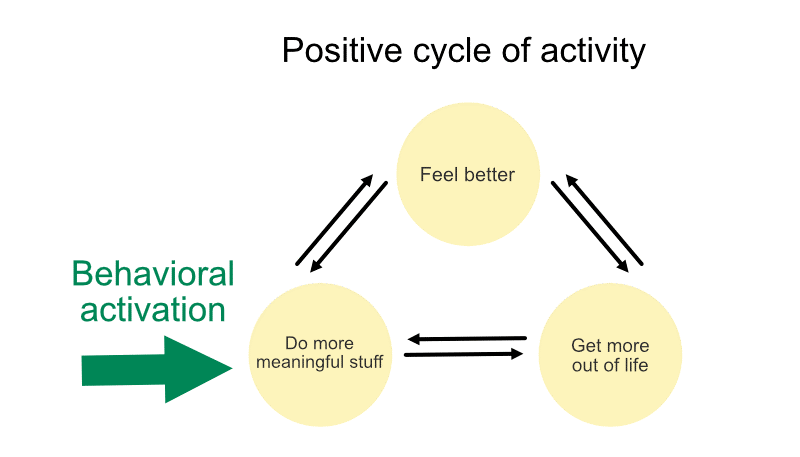Overcoming Depression Using Behavioral Activation Therapy

An interventional method of psychotherapy, Behavioral Activation or BA aims at helping people stop doing activities that feed their depression or anxiety and engage in activities that they once enjoyed doing.
When I was struggling with my depression, I would sleep until noon, eat, and would go back to sleep. I had stopped writing, reading, baking, or doing anything that I enjoyed. Later, I understood that by avoiding engaging in activities, I let my depression fester and worsen.
Behavioral activation therapy replaces the negative behavior such as sleeping until noon, with positive behaviors. In this article, you’ll read what behavioral activation is and how you can use behavioral activation for depression and anxiety.
What Is Behavioral Activation?

When someone struggles with depression, they lose interest in once pleasurable activities and become less and less active as days go on. When you’re less active, you give your depression more time to fester. Behavioral activation is an evidence-based, practical treatment for depression.
There is a strong connection between our mood and the activities we do. For example, doing something we love gives us pleasure, and engaging in positive conversations with others makes us feel valued and gives us a sense of belonging.
Depressed people tend to experience anhedonia, the loss of interest in activities they once enjoyed. Trapped in a cycle of inactivity and negative thinking, a person is more likely to fall deeper into depression.
BA is a practical way to break the cycle and increase our engagement in activities we’ve lost interest in overtime. Behavioral activation for depression includes:
- Understanding the role of inactivity in worsening depression
- Tracking our daily activities to understand our mood
- Finding out what means the most to us
- Engaging in simple activities to improve our mood gradually
One of the most effective ways to treat clinical depression, behavioral activation can be used along with CBT as well. BA can be classified under third-generation behavior therapy. Other therapies that can be classified under the same are:
- Acceptance and Commitment Therapy (ACT)
- Dialectical Behavioral Therapy
- Functional Analytic Psychotherapy
Read: How Is Behavior Therapy Different From Psychoanalysis?
How Does Behavioral Activation Work?

Behavioral activation is a short-term therapy treatment that can help in improving the mood and inactivity a person struggles with during depression. BA can also help in overcoming symptoms of post-traumatic stress disorder.
When a person is depressed or anxious, they are more likely to lose interest in activities they once enjoyed, hence causing their condition to worsen.
During behavioral activation, you create specific goals for a week and you create a plan to work to help meet the goals. These goals can be anything from your favorite activities to something you want to achieve daily.
For example; Activities that make me feel good include cooking lunch/dinner, hanging out with my friends, and going on a run. Once you have identified your goals, your next step is to plan an action to complete your goals.
This therapy is designed to increase your engagement in positive activities and decrease your engagement in activities that feed your depression, low energy, low mood, inactivity, and anxiety.
How To Use Behavioral Activation For Depression?
Behavioral activation can also be used as a coping method to increase your motivation. Here are some ways you can use behavioral activation to improve your mood and activity:
1. Pick Activities That Mean The Most To You

When using behavioral activation, make sure you pick an activity that means the most to you, not what others say is important. If you’re doing something you like then you’ll find yourself easily motivated and will be able to connect more with what you’re doing. Ask yourself; what matters to you? What do you like doing? This activity is about you, your needs, and your desires.
2. Keep Your Goals Specific & Track Your Progress
Make smart goals and keep track of your progress. If you write down an activity, determine if you can accomplish it or not. Be realistic about your goals and specifications. If an activity you wrote is too vague, then you’ll feel more anxious when it comes to completing it. For example, instead of writing “organize something”, write “organize the bedroom”. This is specific and you can easily track your progress.
3. Rank Your Activities From Easiest To Difficult

Behavioral activation can be difficult when you’re depressed or anxious. In such a case, make sure you list your goals from easiest to difficult. The important thing here is to accomplish your goals and keep moving forward. To achieve this, rank your activities. Start with the easiest one on the top and end with the difficult one. You need to stay active but make sure your activities don’t overwhelm you. Starting small and easy can build up motivation.
Read: What to Say to Someone Who is Depressed?
4. Don’t Stick With The Same Activities
Overcoming depression can be difficult if you’re faced with boredom. To avoid boredom, mix your activities, change your schedule daily, or come up with something new to learn each day. Variety can spice up your life and keep you active.
5. Don’t Shy Away From Asking Help

If you face trouble in staying motivated during behavioral activities, don’t shy away from asking for help from your support system. Connect with your friends and family and let them know what you’re doing and what your goals are for the week. Ask them to help you stay motivated on the path. Check-in with them and ask them to keep a track of your progress. Having a cheerleader on the sidelines can be a great motivator.
6. Be Mindful & Stay In The Present
It’s easy to get lost in your head when you’re depressed and anxious, even if you’re engaged in pleasurable activities. Ruminating on our thoughts, revisiting the past, and worrying about things we can’t control can overpower our needs to be in the present. When you’re engaged in a behavioral activity, try to keep your focus on the task at hand. Don’t let your mind wander down the dark road of rumination.
7. Take One Step At A Time
Behavioral activation is one of the most effective ways to address issues such as avoidance, emotional numbness, and low motivation. When you feel no motivation, anxiety, or depression, it’s important to set realistic, easily achievable goals, and take one step at a time. No one expects you to be okay in a day. Go slow and prepare your goals for a week at a time. Small steps can help bring bigger changes.
You Are Not Alone…

Depression can make you feel alone and isolated. It can make you feel hopeless and leave you drained emotionally and mentally. Therefore, it is important to recognize your efforts, your accomplishments, and reward yourself.
No matter how turbulent your journey maybe, you need to keep taking one step at a time and move on. With the help of behavioral activation therapy for depression, you can take small steps to help you get back into a routine and achieve a meaningful and healthy life.
Remember, you are not alone on your journey and if you need a little hand to help you get up if you fall, you can always reach out to us. Write to us at info@calmsage.com and we’ll give you a helping hand!
When I’m feeling down, I recall the words of a little blue fish, “Just keep swimming”. If Dory didn’t give up, no matter what came her way, then why should you?
Just Keep Swimming…




















